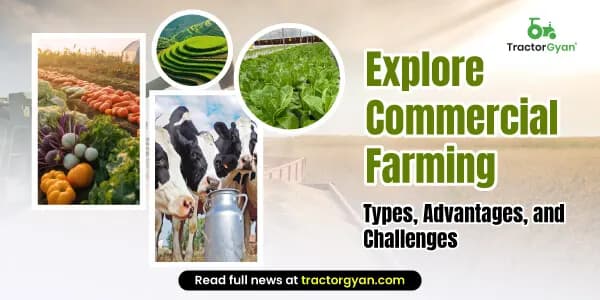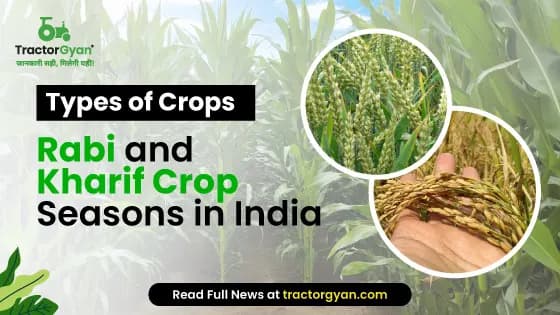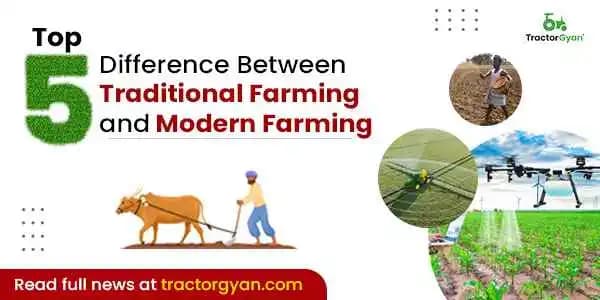Explore Commercial Farming Types, Advantages, and Challenges
Table of Content
Commercial farming, a key pillar of modern agriculture, plays a pivotal role in meeting the global demand for food, raw materials, and exports. By focusing on cultivating a single crop over extensive areas, commercial farmers optimize production and contribute to the economy.
In today’s post, we’re going to discuss commercial farming in India in detail so that if you’re a farmer planning to make a move in this direction, you can easily embark on your journey.
What is Commercial Farming?

Let’s begin the guide by knowing the basics of commercial farming. By definition, commercial farming is a type of farming wherein farmers are involved in the large-scale cultivation of commercial crops and the rearing of animals for the primary purpose of generating profit and economic gain.
Unlike subsistence farming, where the main goal is to meet the basic needs of a family or community, commercial farming focuses on producing surplus agricultural products that can be sold in the market or used for exports. The primary objective of commercial agriculture is to maximize productivity and revenue through efficient agricultural practices.
Features of Commercial Farming
| 1. | Use of high-yielding varieties of seeds |
| 2. | Generates revenue |
| 3. | Heavy use of farming machinery and human labor force |
| 4. | Practiced throughout the 12 months |
| 5. | Creation of capital |
| 6. | Encourages employment at large scale |
| 7. | Decrease the cost of products |

Commercial farming has many features or some distinct characteristics that make it different from other types of farming practiced across the nation. Let's understand this -
1. Use of high-yielding varieties of seeds: One of the specific features or characteristics of commercial farming is that it uses high-yielding varieties of seeds, chemical fertilizers, pesticides, insecticides, and many other things to gain high results.
2. Generates revenue: Commercial farming differs from other types of agriculture in that its products are produced for sale rather than only for personal consumption. This is one of its key distinguishing features. Thousands of acres are used in commercial agriculture to produce goods like cocoa, bananas, rice, sugarcane, tea, and a variety of other things. These goods are produced and primarily exported to other nations.
3. Heavy use of farming machinery: Heavy equipment such as diggers, trailed sprayers, ploughs, planters, and harvesters is also necessary for commercial agriculture. These tools are utilized to meet the deadlines and objectives as well as the production system's talents.
4. Practiced throughout the 12 months: Commercial farmers have year-round irrigation systems. Like other farmers, they don't rely on rain or other natural resources to keep their crops or animals alive throughout the year. Instead, they use contemporary tools, technology, and artificial growth promoters.
5. Creation of capital: Commercial farming is a type of farming that is beneficial not only for the agricultural sector but also for industries or investors as it leads to the creation of capital.
6. Encourages employment at a large scale: Commercial farming allows people who live in the area to find work. The workers are paid a wage that allows them to feed their families. Thus, commercial farming encourages the expansion of the regional economy.
7. Decrease the cost of products: Due to the sufficient supply of crops on the market, commercial agriculture helps to lower the price of agricultural products. Therefore, the forces of supply and demand work to drive down the cost of such commodities.
Different Types of Commercial Farming
| 1. | Dairy Farming |
| 2. | Grain Farming |
| 3. | Live Stock Farming |
| 4. | Plantation Farming |
| 5. | Monoculture Farming |
| 6. | Poultry Farming |
| 7. | Aquaculture |
| 8. | Commercial Floriculture |

Commercial farming is practiced mainly for monetary purposes, and it also boosts the economy because of the large-scale production it carries out. All commercial farming examples are listed below.
Commercial Agriculture Types are:
1. Dairy farming

Dairy Farming is a type of commercial agriculture, and as the name suggests, it is mainly involved in the production of milk and milk products. In Dairy farming, the primary purpose is to rear cattle, which gives out milk and other dairy products in return.
2. Grain Farming

Commercial Grain farming is a type of industrial farming in which grains, including corn, barley, and wheat, are cultivated for human consumption and export. It is crucial to note that commercial grain farming is highly mechanized and necessitates enough land, equipment, farmers, and more.
3. Livestock Farming

Livestock farming is a type of farming wherein animals are reared to obtain meat. Cattle and sheep are the most frequent species raised in livestock farming, although on some farms you may also find pigs and poultry raised in huge numbers.
4. Plantation Farming

This type of commercial agriculture is very similar to commercial farming under plantation farming. A large piece of land is used to cultivate cash crops like sugar, tea, coffee, bananas, coconut, etc., which are then sold in the global market to receive excessive revenues.

5. Monoculture Farming

This type of commercial farming involves the cultivation of a single crop over large expanses of land. It’s one of the most common commercial farming examples seen in India, and it focuses on maximizing the yield and efficiency of a particular crop and creating a surplus. Commercial crops like wheat, corn, soybeans, and rice are mostly cultivated as these are the staple grains in India and are important for feeding the huge population of this nation.
6. Poultry Farming

The next type of commercial farming, which is very common in India, is poultry farming, which involves raising chickens, ducks, turkeys, and other birds for meat and egg production. Poultry farming has become highly mechanized and intensive to meet the growing demand for poultry products.
7. Aquaculture

Also known as fish farming, aquaculture involves the breeding and rearing of fish, crustaceans, and aquatic plants in controlled environments such as ponds, tanks, and ocean enclosures. This type of farming caters to the demand for seafood and helps conserve wild fish populations.
8. Commercial Floriculture

Commercial floriculture in India involves the large-scale cultivation of flowers and ornamental plants for the floral industry. Flowers are grown for various purposes, including floral arrangements, bouquets, and decorations.
Advantages of Commercial Farming
Commercial farming or commercial plantation is more than just a farming practice that farmers in India have been adopting for ages. It's there to take care of people's daily eating needs and allow a nation to become economically strong through exports.
Here are a few advantages that this age-old practice brings to the table.
-
Commercial farming boosts the power supply to areas in the suburbs of farmed land since it uses machinery and electricity.
-
It contributes to the improvement of local infrastructure. Roads are paved to facilitate the transit of goods and equipment quickly and comfortably.
-
Commercial farming is an easy way to boost a nation's employment ratio. It creates multiple work opportunities for people in the surrounding region. To put it another way, commercial farming can help boost the local economy.
-
As commercial farming is mainly practiced for profit earning, it helps in foreign exchange policies. Cocoa, coffee, and other non-traditional agricultural export commodities generate foreign exchange for their countries.
Challenges to Commercial Farming in India
In India, commercial farming is essential for increasing food availability and, hence, supporting the national economy. However, it addresses some significant obstacles restricting output and expansion.
-
Small plots dominate India's landmass. Hence, commercial farmers need help to apply contemporary technologies, farming techniques, or extensive operations.
-
Irrigation remains a significant issue, and unpredictable monsoons influence crop yields. Excessive groundwater extraction and inadequate water management strategies exacerbate the issue.
-
The costs of tools, fertilizers, pesticides, and seeds may surpass the revenues of small-scale commercial farmers. As they have to worry about money, they find it more difficult to try new activities.
-
Supply chain management is challenging when problems arise with storage space, transportation networks, and access to the newest technologies.
-
Soil deterioration, biodiversity loss, and climate change are undermining the reliability of industrial agriculture.
Addressing these issues by establishing new regulations, employing sustainable practices, and enhancing technology is imperative. This approach ensures the future sustainability of commercial farming in India.
Difference Between Commercial Farming and Subsistence Farming
Subsistence farming and commercial farming are two distinct agricultural practices with different objectives and characteristics. Here are the main differences between the two:
| Aspect | Subsistence Farming | Commercial Farming |
| Objective | Produce enough for family consumption | Produce for sale in the market for profit |
| Scale | Small-scale | Large-scale |
| Production Intensity | Relies on traditional methods | Utilizes modern machinery and technology |
| Crop Selection | Diverse, including staple foods and vegetables/fruits | Focuses on high-value cash crops or livestock |
| Income Source | Mainly from off-farm work or small-scale local trade | Primarily from selling agricultural products in the market |
| Risk Management | Higher risk due to environmental factors and market flux | May implement risk management strategies |
| Dependency on Markets | Less reliant on external markets | Highly dependent on market conditions |
Both subsistence farming and commercial farming play vital roles in global food production, and each has its unique advantages and challenges. Some regions practice a mix of both types of farming, depending on factors such as local traditions, land availability, and economic conditions.
Conclusion
Farming of all sorts is important for a nation’s growth and its people. Commercial farming is one type of farming that serves both purposes. Cultivation of a crop at a large scale creates export opportunities while having sufficient crops to feed the nation.
Multiple types of commercial farming exist, so farmers have no dearth of options. They can pick suitable forms of commercial farming and build a nation and substantial wealth for themselves.
Category
Read More Blogs
How often do we see heaps of dried crops burning on the fields during the end of a crop cycle, well these burning crops are not arson or an accident, it is what the professionals and experts call Stubble-burning. They are...
Mumbai, November 1, 2022: Mahindra & Mahindra Ltd.’s Farm Equipment Sector (FES), part of the Mahindra Group, today announced its tractor sales numbers for October 2022.
Domestic sales in October 2022 were at 50539 units, as against 45420 units during October 2021.
Total...
Vst is a well-known and century-old tractor manufacturing company situated in India south. It was founded in 1967 and has since expanded into the sales and marketing of tractors and tillers, leaving all its competitors in the dust. They sell adjusted and inherent...
Write Your Comment About Explore Commercial Farming Types, Advantages, and Challenges
.webp&w=1920&q=75)
Top searching blogs about Tractors and Agriculture
30 Jul 2025
30 Jul 2025
29 Jul 2025
29 Jul 2025
03 Jul 2025
30 Jul 2025
30 Jul 2025
30 Jul 2025
29 Jul 2025
30 Jul 2025
31 Dec 2024
31 Jul 2025
30 Jul 2025
31 Jul 2025















.webp&w=3840&q=75)









.webp&w=3840&q=75)
.webp&w=3840&q=75)



























